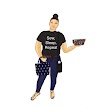Sew an Eye Mask
This is a wonderful, easy item to sew. You can give this as a stocking stuffer to a family member, make matching ones, or give it as a gift for that person that has light sensitivity. I love using these for road tripping, or simply, to help me reduce light when I have a migraine. Flannel and fleece are comfortable materials that will provide a soft, cushy feeling against your eyes. Dark color interior helps for that as well. The final measurements are approximately 4" x 8" so once again, you can use scraps for this project.
Grab a link from below for an eye mask. They are not mine.... just some I found online. If you do not like them, you could download your own pattern from off the internet, for free, there are many, OR head to the dollar tree and buy a thin, cheap one that you rip at the seams and use as a pattern.
To sew, gather the following materials:
 |
1 outer layer of cotton fabric
1 lining (go rest against your eyes)
1 layer of fleece OR flannel
12" elastic that measures 1/8 " or thicker
Let's get started!
Get the lining fabric, the material that will be placed on your eyes. Place that material on top of the outer fabric and elastic. You will be creating a sandwich. Next, place the fleece, or flannel layer on top of that lining fabric. You will need to fold the middle of the elastic inwards, as it is too long. You only want about 1/4' left outside of the mask (with the raw edges). Pin sideways to ensure catching the elastic. Pin. Starting at the top of the mask on one side, sew all the way around the mask leaving a gap on the top - to turn right side out. I find it easier to sew along a straight edge, instead of a curve when you want to topstitch an item.
Turn the mask right side out. Use a chopstick, or pencil with and eraser, to smooth around the curved edges inside of the mask. Iron flat. This will help flatten the seams inside that you cut, to prepare for the next step.
Top stitch around the mask. When sewing around the curves, you may want to use a smaller stitch length than you are use to. It makes it easier to go around curves and turn item. I found this particularly helpful when sewing around the nose/bridge area as well.
That's it! Simple. Easy!
If you end up sewing someone a pair of pajamas, this will be a cool item to add as a matching accessory.







0 Comments